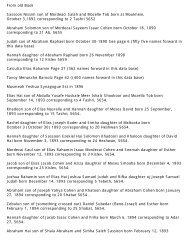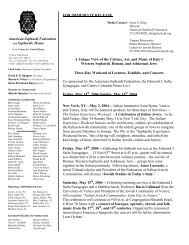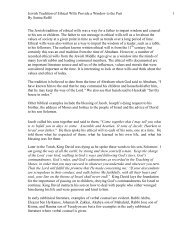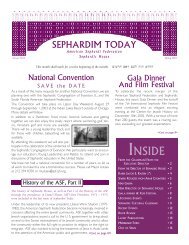The Historic Synagogues of Turkey - American Sephardi Federation
The Historic Synagogues of Turkey - American Sephardi Federation
The Historic Synagogues of Turkey - American Sephardi Federation
You also want an ePaper? Increase the reach of your titles
YUMPU automatically turns print PDFs into web optimized ePapers that Google loves.
<strong>The</strong> <strong>Historic</strong> <strong>Synagogues</strong> <strong>of</strong> <strong>Turkey</strong>Houses <strong>of</strong> Jewish worship - large and small, monumental and humble - once dottednearly every city and town in the vast and powerful Ottoman Empire and its successor,the Republic <strong>of</strong> <strong>Turkey</strong>. Of those synagogues, scores have been abandoned and collapsed,<strong>of</strong>ten with little record <strong>of</strong> their existence. Many others, <strong>of</strong>ten on valuable real estate, standon the verge <strong>of</strong> collapse. Yet others stand proud and well-maintained. <strong>The</strong>y continue t<strong>of</strong>unction as they have for centuries, although the number <strong>of</strong> worshipers has been greatlydiminished by emigration.<strong>The</strong> photographs in this exhibition <strong>of</strong>fer a glimpse into an intriguing world: thesynagogues <strong>of</strong> the largest Jewish community in any Muslim country. <strong>The</strong>se synagogueswere built by members <strong>of</strong> a substantial and influential Jewish minority who were invitedto - and helped shape - a powerful Muslim empire situated at the very edge <strong>of</strong>Christendom and Europe.Despite the compelling history and rich culture <strong>of</strong> the Ottoman and Turkish Jewishcommunities, there had been no comprehensive documentation <strong>of</strong> the artistic andarchitectural heritage <strong>of</strong> its synagogues until this project began. It became imperative tostudy what still remains before it is lost.With this in mind, and with the generous support <strong>of</strong> the Maurice Amado Foundation andthe Mitrani Family Foundation, I set out with a research team for two months in late1996. Our goal was to chronicle - through photography, measured architectural drawingsand written description - synagogues throughout <strong>Turkey</strong>. This was a continuation <strong>of</strong>similar efforts I have undertaken in Morocco, India and Romania.We traveled 6,000 miles to document and analyze fifty synagogues and formersynagogues, resulting in 3,000 photographs and 150 measured architectural drawings.<strong>The</strong> Ottoman Empire, once great and feared by the rulers <strong>of</strong> Christendom, was by nomeans a simple and homogenous cultural entity. <strong>The</strong> Empire's reach extended to Europe,Asia and Africa, comprising a complex, multi-cultural, multi-racial, and multi-religioussociety. One <strong>of</strong> the factors in the longevity <strong>of</strong> the Ottoman Empire was its laissez-faireattitude towards minorities; within its boundaries were Greek, Armenian, Slavic, CentralAsian, Arab and North African communities.Although the presence <strong>of</strong> Jewish communities in Constantinople and Anatolia dates toByzantine times, its "Golden Age" did not begin until the Ottoman capture <strong>of</strong>Constantinople (renamed Istanbul) in 1453. A long line <strong>of</strong> Sultans invited persecutedEuropean Jews to resettle within the expanding Empire in areas where their skills wereneeded. Most prominent were the <strong>Sephardi</strong>m expelled from the Iberian Peninsula in1492.
Each minority group was allowed to maintain and develop its own language, religion, andculture to varying degrees and always within certain parameters. <strong>The</strong> Pact <strong>of</strong> Omar -which established protection for Christians and Jews, limited their privileges andsubjected them to special taxes - was never enforced with the same rigor that it <strong>of</strong>ten wasin other parts <strong>of</strong> the Muslim world.In the heyday <strong>of</strong> the Ottoman Empire, Jewish learning and culture thrived, producing amaterial culture and architecture which merged the spiritual and religious priorities <strong>of</strong>Judaism with an architectural vocabulary that was rooted in the Islamic world andcentered in the Ottoman Empire. From the beginning, Jews built places <strong>of</strong> worshipwherever they were settled. Some were small, contained within private homes; otherswere more prominent. In certain cases, they were endowed by the Sultan.As long as the Ottoman Empire thrived, segments <strong>of</strong> the Jewish community were quiteprosperous. Jews brought the first printing presses to the Ottoman Empire, served as theSultan's ambassadors to European countries and were tailors to the elite private guard <strong>of</strong>the Sultan.With the protracted downfall <strong>of</strong> the Empire in the 18th and 19th centuries, culminating ina series <strong>of</strong> wars and invasions in the early 20th century, the Jewish community lost much<strong>of</strong> its strength and became impoverished.<strong>The</strong> ruins <strong>of</strong> the Ottoman Empire have emerged as a complex, modern Republicbalancing its secular foundation with its religious heritage, balancing and its eastern rootswith its conscious choice to turn its face to the West. Substantial Jewish populationsremain only in Istanbul (20,000) and Izmir (2,000). In many communities, a minyan(quorum <strong>of</strong> ten needed for communal prayer) can no longer be formed. Much <strong>of</strong> thepopulation is elderly and last year, deaths outnumbered births nearly three to one. In 1908there were 22,000 Jews in the western city <strong>of</strong> Edirne; in 1997, only two remain.Turkish Jews are guaranteed complete freedom <strong>of</strong> worship. Many are quite proud andcomfortable; others feel a need to maintain a lower pr<strong>of</strong>ile. Turkish schoolchildren arenot taught about the role <strong>of</strong> minorities in the successes <strong>of</strong> the Ottoman Empire and<strong>Turkey</strong>; many younger Turks, as a result, are not aware <strong>of</strong> the fact that there was once asignificant Jewish population; others commonly confuse Jews with Greeks andArmenians.<strong>The</strong> last few years have seen a strengthening <strong>of</strong> Islamic Fundamentalism - including ayear in which the Welfare Party headed a coalition government. Yet a majority <strong>of</strong> Turkscontinue to believe very strongly in the fundamental importance <strong>of</strong> the secularunderpinnings <strong>of</strong> the Republic.<strong>The</strong> synagogues which are the legacy <strong>of</strong> this Jewish community maintain a wide variety<strong>of</strong> forms. Some were simply converted from rooms in pre-existing buildings; others(usually <strong>of</strong> the 19th and 20th century) have grand interiors and monumental facadeswhich incorporate Jewish symbols. Most synagogues are preceded by courtyards, which
serve as a transition between the public realm <strong>of</strong> the street and the private realm <strong>of</strong> thesynagogue. Many courtyards serve as the entrance to the women's gallery and as a placefor the Sukkah.Many interiors embody a lavish richness <strong>of</strong> architecture and furnishings, <strong>of</strong>ten with plushTurkish rugs, ornate oil lamps crafted from silver, carved wooden furnishings andspectacular embroideries. <strong>The</strong>re is a consistent emphasis on those places most importantfor Jewish worship - the Ark (where the Torah is housed - known as Hechal among<strong>Sephardi</strong> Jews) and the platform from where the Torah is read (known as the Tevah).Most synagogues have a smaller room, the Beit Midrash (the House <strong>of</strong> Study), whichserves as a sanctuary for daily use.Many synagogues share similar forms. In the region <strong>of</strong> Izmir, many are square in plan. Inthese, four central columns create a nine-square grid. <strong>The</strong> central square <strong>of</strong> the gridcontains a raised area in which the central tevah is placed (this synagogue plan is found inother countries as well). Other synagogues, in the region <strong>of</strong> Bursa, have a central tevahsurrounded by a circle or ellipse <strong>of</strong> columns; a second tevah is placed on a mezzanineover the entrance.<strong>The</strong>se synagogues are a body <strong>of</strong> an architecture which merge the priorities <strong>of</strong> Jewishritual with the architecture <strong>of</strong> the Islamic and Ottoman worlds in which they wereimmersed.<strong>The</strong> degree to which Jews embraced Ottoman ideals and culture is exemplified by theArk (hechal) <strong>of</strong> the Ashkenazi synagogue in Istanbul (c. 1905), whose design stronglyrecalls an Ottoman pavilion. Likewise, this melding <strong>of</strong> Islam and Judaism is manifest inthe Menorah <strong>of</strong> Beit Israel (in Izmir) and the keystone over the Ark in ShaarHashamayim, (also in Izmir), both <strong>of</strong> which feature the star and crescent - the mostprominent symbols <strong>of</strong> Islam and the Ottoman Empire.While the images in this exhibition may have a certain poetic quality, each <strong>of</strong> thesesynagogues has its own soul and a story to tell; its history is the history <strong>of</strong> generations <strong>of</strong>Jewish families in communities that no longer exist. Looking beyond the images, thisproject raises a series <strong>of</strong> questions: Do these sites merit preservation? If so, whoseobligation is it? If they are restored, how would they be used and what value would theyhave?Ceren Kahraman, our team member from Istanbul, <strong>of</strong>fers the following perspective: "ForTurks, these synagogues are an important part <strong>of</strong> our cultural history. <strong>The</strong>y are in danger<strong>of</strong> being lost and this would be to the detriment not just <strong>of</strong> Turkish Jews, but <strong>of</strong> allTurks."<strong>The</strong>se synagogues serve as a reminder <strong>of</strong> a nearly-forgotten world where Jew and Muslimlived side-by-side. Prior to this century, in fact, in many Muslim countries, peacefulJewish-Muslim coexistence was the norm and not the exception.
In the turbulence <strong>of</strong> today's Middle East, it is easy to forget the long and fruitful chapter<strong>of</strong> Jewish-Muslim coexistence. Perhaps the value <strong>of</strong> these synagogues lies in their abilityto serve as a poignant reminder <strong>of</strong> such a world.














